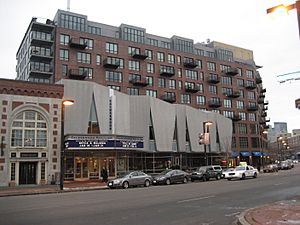Boston Center for the Arts facts for kids
The Boston Center for the Arts (BCA) is a special non-profit place for visual and performing arts. It's located in the South End neighborhood of Boston, Massachusetts. The BCA has many spaces for shows, rehearsals, and art exhibits. It's also where the Boston Ballet and other art groups are based. The BCA's main building, the Cyclorama, is a very old and important landmark.
Contents
Discovering the BCA's History
How the BCA Started
The Boston Center for the Arts began in 1970. The Boston Redevelopment Authority wanted to make the South End area better. They set aside a city block for a new arts center. The city of Boston bought the old Cyclorama Building and nearby buildings. They then leased them to the new BCA for a small yearly fee. The BCA is in charge of taking care of its historic campus.
The Amazing Cyclorama Building
The Cyclorama is a large, round building. It was built in 1884 by Charles Amos Cummings and Willard T. Sears. It was made to hold a huge painting called Battle of Gettysburg. This was a panoramic painting by the French artist Paul Philippoteaux.
The building first looked like a fortress. It had towers and a grand arch at the entrance.
Changes Over the Years
Between 1899 and 1922, the Cyclorama building was used for many different things. It was a garage, a boxing ring, and even a car workshop. In 1922, the Boston Flower Exchange bought the building. They used it as their main office and for flower shows. During this time, the building's outside look changed. The towers were removed, and the arch was taken down. The copper dome on top was replaced with a glass skylight.
In 1967, the Boston Redevelopment Authority started planning a new arts center. This idea came from Royal Cloyd, a South End resident. He saw the need for affordable spaces for artists. The Cyclorama building and other nearby buildings were chosen for the new arts center. Since then, the BCA has grown a lot. It is now one of Boston's top art organizations.
New Additions to the BCA
In 2004, the BCA partnered with the Huntington Theatre Company. They built the Stanford Calderwood Pavilion. This was the first new theater built in Boston in over 75 years. The Calderwood Pavilion stands where the old National Theater used to be. That theater hosted famous performers like Sammy Davis Jr. and Duke Ellington.
Exploring BCA Facilities
The Cyclorama Building Today
The Cyclorama Building is the BCA's original and main building. Today, it's a key way the BCA earns money. People can rent the Cyclorama for many events. These include fundraisers, trade shows, and corporate events. It also hosts art exhibits, performances, and weddings. The ground floor of the Cyclorama is home to C.P Casting. This is a major Boston company that finds actors. It also houses the Community Music Center of Boston. This center offers music lessons to thousands of people each year.
Stanford Calderwood Pavilion
Built in 2004, the Stanford Calderwood Pavilion is a large complex. It has two main theaters:
- The 372-seat Virginia Wimberly Theatre
- The 200-seat Nancy and Edward Roberts Theatre
It also has rehearsal rooms, a box office, and public areas. The Huntington uses the Wimberly Theatre for some of its shows. The BCA’s Resident Theater Companies perform in the Roberts Studio Theatre. The SpeakEasy Stage Company performs all its shows in the Roberts Studio Theatre.
Plaza Theaters
The Plaza Theaters are performance spaces for the BCA's Resident Theater Companies. These companies include The SpeakEasy Stage Company, Company One, The Theater Offensive, and The Pilgrim Theater. There are two main Plaza Theaters:
- The Plaza Theater: This theater has fixed seats and holds about 150 people.
- The Black Box Theater: This is a flexible space that can hold about 50 people.
Artist Studios
The Artist Studios offer affordable workspaces. Over 50 artists and art groups use these studios. Some of the groups include the Commonwealth Shakespeare Company and the City Stage Company. Other groups are The Art Connection, The Color of Film, South End Strings, FluteFX, and Filkela Films.
Mills Gallery
The Mills Gallery is a large, non-commercial art gallery. It has three separate spaces. The gallery hosts five big exhibitions each year. It also has many smaller shows and events. It displays art from both famous and new artists from around the world.



